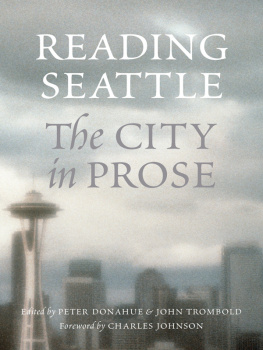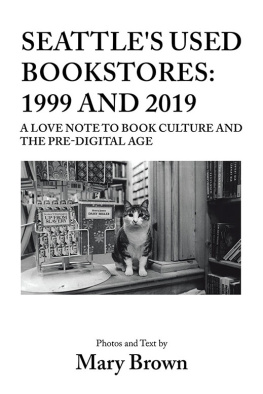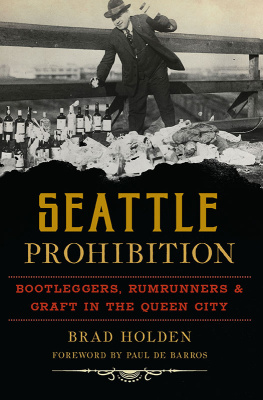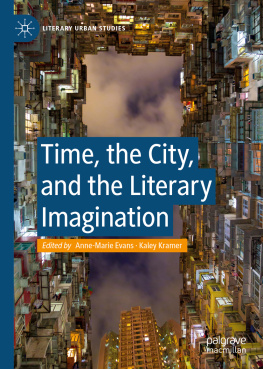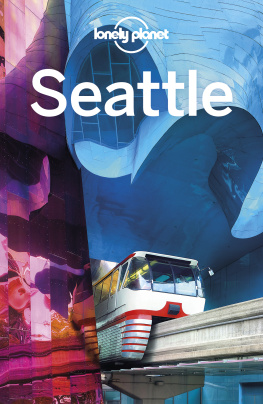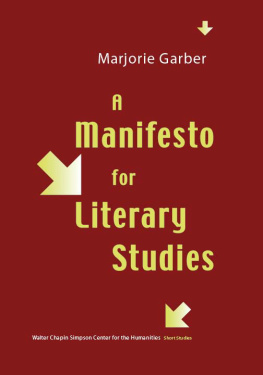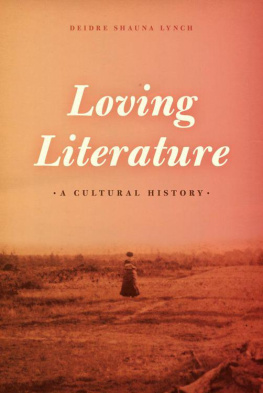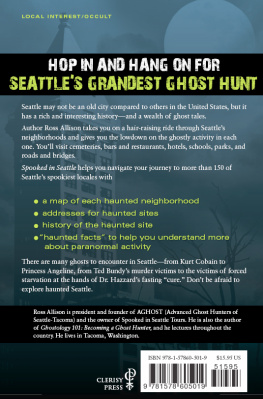Copyright 2015 by Ryan Boudinot
All rights reserved. No portion of this book may be reproduced or utilized in any form, or by any electronic, mechanical, or other means, without the prior written permission of the publisher.
Editor: Hannah Elnan
Production editor: Emma Reh
Design: Anna Goldstein
Map illustrator: Teresa Grasseschi
Copyeditor: Elizabeth Johnson
Library of Congress Cataloging-in-Publication Data is available.
ISBN: 978-1-57061-986-1
eBook ISBN: 978-1-57061-987-8
Sasquatch Books
1904 Third Avenue, Suite 710
Seattle, WA 98101
(206) 467-4300
www.sasquatchbooks.com
v3.1
CONTENTS

SEATTLE, CREATIVE CITY
BY RYAN BOUDINOT
But those of us who write here know in our bones that this is a city with rare devotion to the written word. For this anthology, a representative selection of the citys writers and book lovers were invited to share their favorite stories of literary Seattle. I told the contributors I wanted to hear the kinds of stories theyd tell in a bar, among their writer friends, after the third round. Judging by some of the submissions I received, some of the writers took this directive more literally than others.
But to understand Seattle as a place for readers, writers, and books, its helpful to situate literature within the context of a city where many forms of creative expression flourish and influence one another. Artistswhether theyre musicians, dancers, actors, filmmakers, visual artists, etc.thrive here.
If you lived in the Pacific Northwest prior to the World Wide Web, it was easy to assume that the world at large didnt know this corner of the country existed. The cultural umbilical cords that originate in New York and Los Angeles sent their movies, TV shows, bands, and books our way, and we devoured what was served. I have fond memories of chopping wood in a Skagit Valley sheep pasture while blasting N.W.A.s Straight Outta Compton on a boom box, and reading about the coked-up demimonde of Jay McInerneys Bright Lights, Big City while on a school bus passing tulip fields.
For much of the Northwests cultural history, our purpose seemed to be that of passive consumers of culture, or at best a farm team whose brightest artists (Frances Farmer, Jimi Hendrix, Merce Cunningham, et al) decamped for the countrys real cultural production centers. When an artistic genius rose from the Pacific Northwest, he or she was quickly swallowed, like a comedian from neighboring Canada, by Americas entertainment machine.
Pre-Internet, we were sort of left to our own devices here in the upper left corner. Once in a while, a news magazine would swoop in to explain us. They sure do drink a lot of fancy coffee up there! Whats with those salmon? Hey, look, software! It rains a lot!
In the funky 80s, Tacoma-native Gary Larson produced The Far Side, the one-paneled masterpiece that shook up the Garfield orthodoxy of the inaptly named funny pages. Raymond Carver, who grew up in Yakima, had started his long occupation of MFA program syllabi. The documentary Streetwise, about Seattles homeless children, played on local TV with all the curse words intact, painting the city as an unforgiving concrete netherworld crawling with pederasts and drug dealers. The riotous comics of Matt Groening and Lynda Barry, both graduates of The Evergreen State College in Olympia, started appearing in alt weeklies and on office break-room bulletin boards.
In the early 90s, Washington State would show off its Douglas firs and dark secrets on national television with Twin Peaks, cocreated by David Lynch, who spent part of his childhood in Spokane.
Then God plugged a guitar into an amplifier. And there was a screech of feedback. And it was good. More to the point, it was loud.
The moment I realized that truly cool art could come from Seattle was when I dropped the needle on Mudhoneys self-titled LP. What impressed me most about that album, and about Mudhoney in general, was that they seemed utterly uninterested in impressing anybody. (During a free outdoor show at Seattle Center, lead singer Mark Arm declared, Say what you will about Mudhoneyyou get what you pay for.) They created snotty, aggressive, vulgar music in a garage somewhere, and they didnt seem to care what anybody thought. This attitude pervaded the scene. I bought as many tapes (yes, cassettes!) by local bands as I could afford. If the band lived in Seattle and the members all wore their hair past their nipples, I figured they were worth checking out. I had no clue what Soundgarden sounded like when I purchased Ultramega OK. I bought Bleach thinking that the name Nirvana really should have belonged to a more famous band.
What happened next, of course, is history well-preserved in Seattles EMP Museum, or what I like to call the Museum of Twelve-Year-Old Boys Bedrooms. Grunge changed popular music for the better, and while the plaid flannel and vintage distortion pedals got a lot of attention and occasional ridicule, there were three crucial elements of that music that provided a model for how artists in the Northwest might engage the world.
First, the lyrics. The wave of musicians that included Kurt Cobain, Kathleen Hanna, Chris Cornell, and Carrie Brownstein came into their own during a period when American popular music was, lyrically, pretty much the exact opposite of everything Bob Dylan has ever stood for. Thanks to Seattle bands, we went from shes my cherry pie to raining icepicks on your steel shore almost overnight. Grunge took the DIY ethos of Washington, DCs hardcore scene, kicked the misogyny out of metal, and added poetry. When Kurt Cobain lived on Pear Street in Olympia, it would take him just a couple minutes to walk to Counterpoint Books, a used bookstore owned by a curmudgeonly leftist with questionable shelving skills. Its here, I imagine, that Cobain encountered books by Thomas Pynchon and William S. Burroughs, whose prose informed his lyrics. This store, later sold to the original owners daughter, would become Orca Books, where I worked for a time after college, and where I occasionally sold books to the members of Sleater-Kinney. I submit that the secret ingredient of the Northwests late twentieth-century musical renaissance was prose.
With a much more diverse palette of lyrical content came an attitude shift toward those who were frequently marginalized by American popular music. The poodle-haired heteronormative rock god became instant self-parody the moment Kurt put on a dress. Women claimed more of their rightful place in rock musics canon, and, thanks largely to the Riot Grrl movement, launched the third wave of feminism, running Susan Faludis sexual politics through Marshall stacks. Homophobia became profoundly uncool. Those of us who frequented punk shows in the early 90s remember the vibesupportive, self-reliant, open to experimentation, accepting of differences. These values bled into other artistic forms. I was among many young writers who took artistic cues from albums as much as books.
And its clear that this reassertion of values wasnt fleeting. Theres a straight (queer?) line from Cobains What else should I say? / Everyone is gay to Seattle hip-hop giant Macklemores Same Love. The embryonic version of the newspaper that would become Seattles



